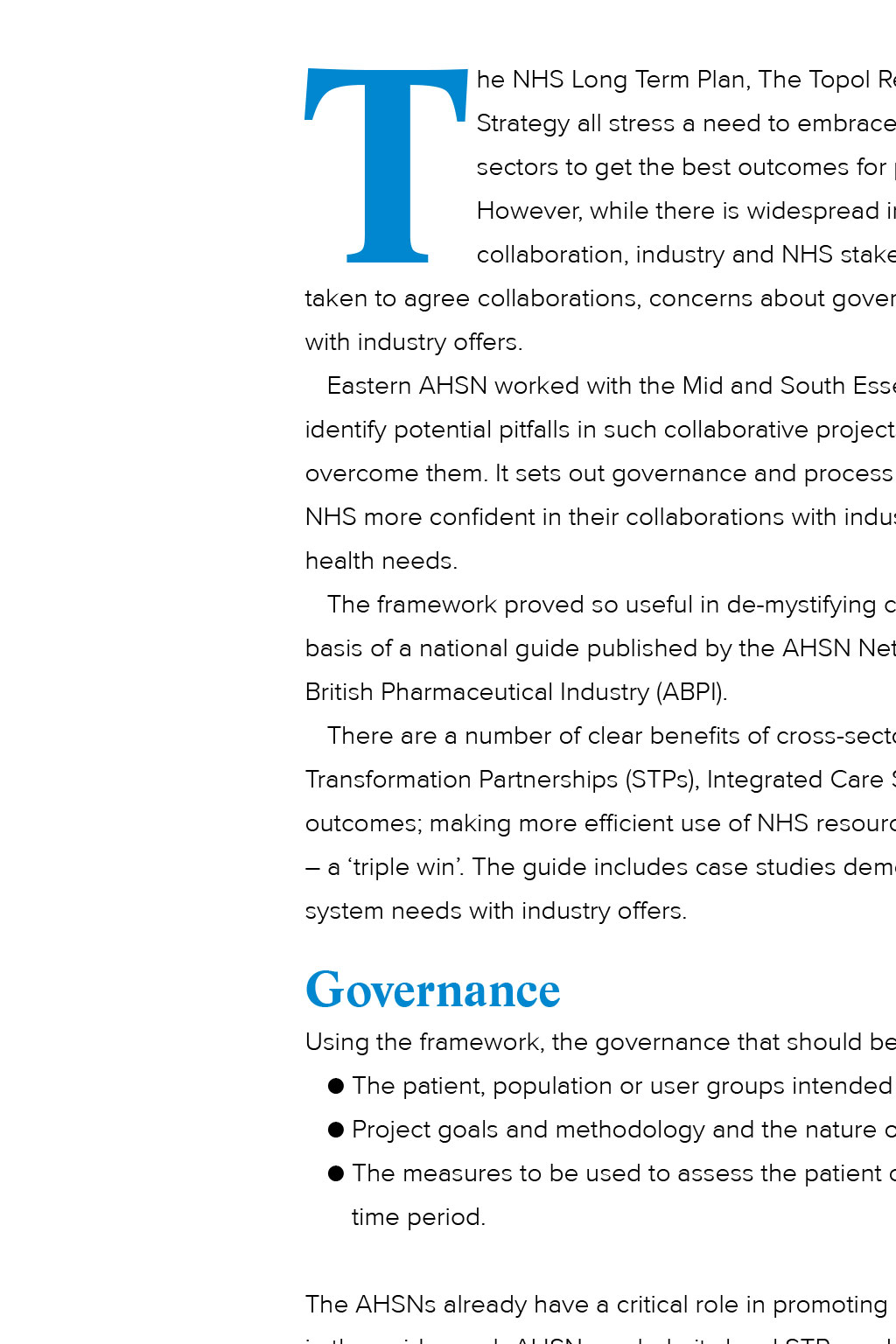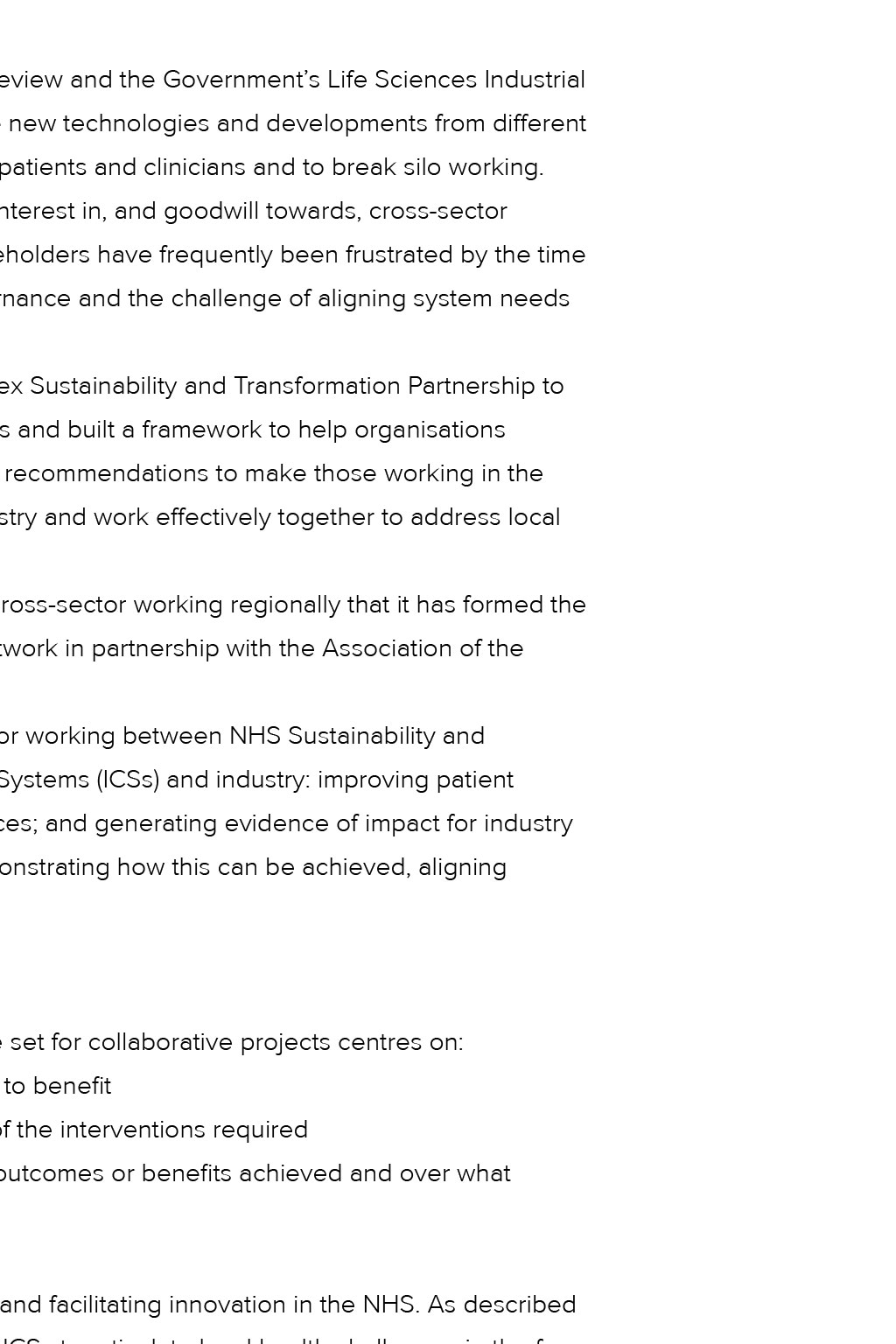












National guide: Cross-sector working New drive to support NHS-industry collaboration A new guide developed by Eastern AHSN and Mid and South Essex STP, in partnership with the ABPI, points the way to better cross-sector working between the NHS and industry The NHS Long Term Plan, The Topol Review and the Government’s Life Sciences Industrial Strategy all stress a need to embrace new technologies and developments from different sectors to get the best outcomes for patients and clinicians and to break silo working. However, while there is widespread interest in, and goodwill towards, cross-sector collaboration, industry and NHS stakeholders have frequently been frustrated by the time taken to agree collaborations, concerns about governance and the challenge of aligning system needs with industry offers. Eastern AHSN worked with the Mid and South Essex Sustainability and Transformation Partnership to identify potential pitfalls in such collaborative projects and built a framework to help organisations overcome them. It sets out governance and process recommendations to make those working in the NHS more confident in their collaborations with industry and work effectively together to address local health needs. The framework proved so useful in de-mystifying cross-sector working regionally that it has formed the basis of a national guide published by the AHSN Network in partnership with the Association of the British Pharmaceutical Industry (ABPI). There are a number of clear benefits of cross-sector working between NHS Sustainability and Transformation Partnerships (STPs), Integrated Care Systems (ICSs) and industry: improving patient outcomes; making more efficient use of NHS resources; and generating evidence of impact for industry – a ‘triple win’. The guide includes case studies demonstrating how this can be achieved, aligning system needs with industry offers. Governance Using the framework, the governance that should be set for collaborative projects centres on: ● The patient, population or user groups intended to benefit ● Project goals and methodology and the nature of the interventions required ● The measures to be used to assess the patient outcomes or benefits achieved and over what time period. The AHSNs already have a critical role in promoting and facilitating innovation in the NHS. As described in the guide, each AHSN can help its local STPs and ICSs to articulate local health challenges in the form of a call to industry and by providing a robust process for selecting the best industry partner/partners to address the challenges identified. This will mean that cross-sector projects have the best chance of succeeding. ● Read the full guide here National guide: Cross-sector working A new guide developed by Eastern AHSN and Mid and South Essex STP, in partnership with the ABPI, points the way to better cross-sector working between the NHS and industry The NHS Long Term Plan, The Topol Review and the Government’s Life Sciences Industrial Strategy all stress a need to embrace new technologies and developments from different sectors to get the best outcomes for patients and clinicians and to break silo working. However, while there is widespread interest in, and goodwill towards, cross-sector collaboration, industry and NHS stakeholders have frequently been frustrated by the time taken to agree collaborations, concerns about governance and the challenge of aligning system needs with industry offers. Eastern AHSN worked with the Mid and South Essex Sustainability and Transformation Partnership to identify potential pitfalls in such collaborative projects and built a framework to help organisations overcome them. It sets out governance and process recommendations to make those working in the NHS more confident in their collaborations with industry and work effectively together to address local health needs. The framework proved so useful in de-mystifying cross-sector working regionally that it has formed the basis of a national guide published by the AHSN Network in partnership with the Association of the British Pharmaceutical Industry (ABPI). There are a number of clear benefits of cross-sector working between NHS Sustainability and Transformation Partnerships (STPs), Integrated Care Systems (ICSs) and industry: improving patient outcomes; making more efficient use of NHS resources; and generating evidence of impact for industry – a ‘triple win’. The guide includes case studies demonstrating how this can be achieved, aligning system needs with industry offers. Governance Using the framework, the governance that should be set for collaborative projects centres on: ● The patient, population or user groups intended to benefit ● Project goals and methodology and the nature of the interventions required ● The measures to be used to assess the patient outcomes or benefits achieved and over what time period. The AHSNs already have a critical role in promoting and facilitating innovation in the NHS. As described in the guide, each AHSN can help its local STPs and ICSs to articulate local health challenges in the form of a call to industry and by providing a robust process for selecting the best industry partner/partners to address the challenges identified. This will mean that cross-sector projects have the best chance of succeeding. ● Read the full guide here New drive to support NHS-industry collaboration